Klein Tools NCVT-2P Handleiding
Klein Tools
Niet gecategoriseerd
NCVT-2P
Bekijk gratis de handleiding van Klein Tools NCVT-2P (4 pagina’s), behorend tot de categorie Niet gecategoriseerd. Deze gids werd als nuttig beoordeeld door 155 mensen en kreeg gemiddeld 4.7 sterren uit 78 reviews. Heb je een vraag over Klein Tools NCVT-2P of wil je andere gebruikers van dit product iets vragen? Stel een vraag
Pagina 1/4

SYMBOLS ON TESTER / SÍMBOLOS DEL PROBADOR / SYMBOLES SUR LE TESTEUR
Warning – Risk of electric shock / Advertencia: riesgo de choque eléctrico / Avertissement – Risque d'électrocution
Risk of danger. It is important that users of this tester read, understand, and follow all warnings, cautions, Important information:
safety information, and instructions in this manual before operating or servicing this tester. Failure to follow instructions could result
in death or serious injury.
Riesgo de peligro. Es importante que el usuario de este probador lea, comprenda y respete todas las Información importante:
advertencias, precauciones, instrucciones e información de seguridad incluidas en este manual, antes de poner en funcionamiento el
probador o de realizarle servicios de mantenimiento. No seguir estas instrucciones puede dar lugar a lesiones graves o mortales.
Risque de danger. Il est important que les utilisateurs de ce testeur lisent, comprennent et suivent tous les Information importante:
avertissements, mises en garde, information de sécurité et instructions donnés dans le présent guide avant de faire fonctionner ou de
réparer ce testeur. Le non-respect pourrait entraîner des blessures graves, voire la mort.
Double insulated / Doble aislamiento / Double isolation
Read instructions / Lea las instrucciones / Lire les instructions
Conformité Européenne
Conforms with European Economic Area directives.
Cumple con las normas del Área Económica Europea.
Conforme aux directives de l’Espace économique Européen.
This product has been independently tested by Intertek and meets applicable published standards.
Este producto p1-ha sido probado de manera independiente por Intertek y cumple con las normas publicadas vigentes.
Ce produit a été testé de manière indépendante par Intertek et répond aux exigences des normes applicables.
CAT
IV
For measurements performed at the source of low-voltage installation and outside lines.
Para mediciones realizadas en la fuente de la instalación de bajo voltaje y líneas externas.
Pour des mesures prises à la source d’une installation à faible tension et des lignes extérieures.
3
4
1
5
7
6
8
2
ENGLISH
1.NCV Power On/Off Button
2.Power On/Mode LEDs
3.Voltage Detection LEDs (Inside Tip)
4.Non-Contact Tip
5.Pocket Clip
6.O-ring Seal
7.Battery Cap
8.2x AAA Batteries (Included)
NOTE: There are no user-serviceable parts inside tester.
1.
Botón de encendido y apagado "NCV"
2.LED de encendido/modo
3.LED de detección de voltaje (en el interior de la punta)
4.Punta para detección y medición sin contacto
5.Clip de bolsillo
6.Junta tórica
7.Tapa del compartimento de baterías
8.2baterías AAA (incluidas)
ESPAÑOL
NOTA: El probador no contiene en su interior piezas que
el usuario pueda reparar.
1.Bouton marche/arrêt NCV (test de tension sans contact)
2.VoyantsDEL de marche/mode
3.VoyantsDEL de détection de tension (dans la pointe)
4.Pointe sans contact
5.Agrafe pour poche
6.Joint torique
7.Couvercle de piles
8.2pilesAAA (comprises)
FRANÇAIS
REMARQUE: Ce testeur ne contient aucune pièce
réparable par l’utilisateur.
FIG. 1 NCVT-2P
INSTRUCTIONS – Dual-range Non-Contact Voltage Tester (English: page 2)
INSTRUCCIONES – Probador de voltaje sin contacto de rango dual (Español: página 3)
INSTRUCTIONS – Testeur de tension sans contact à double plage (Français : page 4)
DURABILITY / DURABILIDAD / DURABILITÉ
Drop Protection
Protección ante caídas
Protection contre les chutes
6.6 ft.
(2 m)
Safety Rating
Clasificación de seguridad
Cote de sécurité
CAT IV
1000V
• Detects AC voltage from 12 to 1000V with visual & audible indicators
• Two detection ranges: 70 to 1000V and 12 to 1000V
• Auto power-off feature conserves and extends battery life
• Detecta voltaje CA de 12V a 1000V mediante indicadores visuales y audibles
• Dos rangos de detección: 70V a 1000V y 12V a 1000V
• Función de apagado automático que preserva y extiende la vida útil de la batería
• Détecte la présence d’une tension allant de 12 à 1000Vc.a. et la signale au moyen d’indicateurs
visuels et sonores
• Deux plages de détection: 70 à 1000V et 12 à 1000V
• La fonctionnalité d’arrêt automatique permet d’économiser la pile et d’augmenter sa durée de vie

ENGLISH
WARNINGS
To ensure safe operation and service of the tester, follow these
instructions. Failure to observe these warnings can result in severe
injury or death.
• Risk of electric shock and burn. Contact with live circuits could result in death or
serious injury.
• Use caution with voltages above 25V AC as a shock hazard may exist.
• A blinking LED or a steadily illuminated LED in the tip and audible beeps indicate
presence of voltage. If no indication, voltage could still be present.
• Before and after each use, verify operation by testing a known working circuit that is
within the rating of this unit.
• Never assume neutral or ground wires are de-energized. Neutrals in multi-wire branch
circuits may be energized when disconnected and must be retested before handling.
• The tester detect voltage if:WILL NOT
• The wire is shielded.
• The operator is not grounded or is otherwise isolated from an effective earth ground.
• The voltage is DC.
• The tester MAY NOT detect voltage if:
• The user is not holding the tester.
• The user is insulated from the tester with a glove or other materials.
• The wire is partially buried or in a grounded metal conduit.
• The tester is at a distance from the voltage source.
• The field created by the voltage source is being blocked, dampened, or otherwise
interfered with.
• The frequency of the voltage is not a perfect sine wave between 50 and 500Hz.
• The tester is outside of operating conditions (listed in Specifications section).
• Operation may be affected by differences in socket design and insulation thickness
and type.
• In bright light conditions, the LED visual indicators will be less visible.
• When powered-ON, one of the “power-ON” LED’s will be illuminated, and a green light
will illuminate the tip.
DO NOT USE TESTER UNLESS ONE OF THE “POWER-ON” LEDs
IS ILLUMINATED .
• Do not use if tester appears damaged or is not operating properly. If in doubt, replace
the tester.
• Do not apply more than the rated voltage as marked on the tester (1000V).
• Do not apply to uninsulated hazardous live conductors.
• Detection above 70V AC in Mode 1, or above 12V AC in Mode 2 is specified under
"normal" conditions as detailed below. The tester may detect at a different threshold at
different conditions, or may not detect at all unless:
• The tip of the tester is within 0.25" (6 mm) of an AC voltage source radiating unimpeded.
• The user is holding the body of the tester with his or her bare hand.
• The user is standing on or connected to earth ground.
• The air humidity is nominal (50% relative humidity – non-condensing).
• The tester is held still.
• Always wear approved eye protection.
• Comply with local and national safety requirements.
• If this product is used in a manner not specified by the manufacturer, protection
provided by the product may be affected.
OPERATING INSTRUCTIONS
SELECTING VOLTAGE TESTING MODE
NCVT-2P can detect voltage in two distinct modes, defined by the
voltage ranges to which the tester is sensitive. Mode 1 detects 70 to
1000V AC, Mode 2 detects 12 to 1000V AC.
With the tester powered-
ON, successive presses of the NCV Power-ON button
1
will switch
the tester between modes 1 and 2. The Power-ON indicator LED’s
2
will indicate the currently active mode.
The tester will power-ON in the
mode that was most recently used.
OPERATING INSTRUCTIONS
CHECKING FOR THE PRESENCE OF AC VOLTAGE
1. Press NCV Power On/Off button. After performing a self-test, a
green light will illuminate the tip when no voltage is detected.
2. Prior to use, test on a known live circuit to verify tester
functionality.
3. Place tip of the tester
4
near AC voltage. If voltage is present,
the unit will emit audible beeps and the LEDs in the tip
3
will
illuminate:
Mode Power-On
LED Color
12 to 70V AC >70 to 1000V AC
Mode 1
70 – 1000V
Range
Red
No illumination, no
sound Red LED in tip
3
illuminated, continuous
audible beep
Mode 2
12 – 1000V
Range
Blue
Blue LED in tip
3
blinking, pulsing
audible beep
Red LED in tip
3
illuminated, continuous
audible beep
NOTE: In Mode 2, the tester is more sensitive to high voltage sources
and electrically noisy environments. It is recommended to set the
tester to operate in Mode 1 when expected voltages are above 70V AC.
SILENT OPERATION
To activate silent operation, power-ON by pressing and holding the
NCV Power-ON button
1
for more than 2 seconds. Power-ON in this
manner each time silent operation is desired.
CLEANING
Be sure tester is turned off and wipe with a clean, dry lint-free
cloth.
Do not use abrasive cleaners or solvents.
STORAGE
Remove the batteries when not in use for a prolonged period
of time. Do not expose to high temperatures or humidity. After
a period of storage in extreme conditions exceeding the limits
mentioned in the General Specifications section, allow the tester to
return to normal operating conditions before using.
DISPOSAL / RECYCLE
Do not place equipment and its accessories in the trash.
Items must be properly disposed of in accordance with local
regulations. Please see www.epa.gov www.erecycle.org or
for additional information.
CUSTOMER SERVICE
KLEIN TOOLS, INC.
450 Bond Street, Lincolnshire, IL 60069
1-800-553-4676
customerservice@kleintools.com
www.kleintools.com
MAINTENANCE
BATTERY REPLACEMENT
When the battery is low, the unit powers on with a blinking red or blue
LED
2
,
depending on mode most recently used
,
and the batteries must
be replaced.
1. Unscrew the battery cap
7
and remove/recycle spent batteries.
2. Install two new AAA batteries. Note proper polarity.
3. Screw battery cap tightly to ensure a tight seal with the O-Ring
6
.
FUNCTION BUTTONS
NCV POWER ON/OFF BUTTON
1
To activate the Non-Contact Voltage Testing feature, press and
release the NCV Power-ON button. After performing a self-test the
tester will emit a single beep, one of the Power ON LED’s
2
will
illuminate indicating which NCVT mode is active (see OPERATING
INSTRUCTIONS), and a green light will illuminate in the tip
3
.
Topower-OFF the tester, press and hold the NCV button.
NOTE: The tester will automatically power-OFF following 4 minutes
of inactivity to conserve battery life.
CAUTION
• DO NOT attempt to repair this tester. It contains no serviceable parts.
• DO NOT expose tester to extremes in temperature or high humidity.
GENERAL SPECIFICATIONS
The Klein Tools NCVT-2P is a dual-range non-contact voltage tester
(NCVT). It can be set to detect voltage from 70 to 1000V AC (Mode 1),
or from 12 to 1000V AC (Mode 2) for low voltage and higher sensitivity.
• Environment: Indoor or outdoor
• Measurement Range: Mode 1: 70 to 1000V AC
Mode 2: 12 to 1000V AC
• Frequency Range: 50 to 500 Hz
• Batteries: 2x AAA 1.5V Alkaline
• Operating and Storage Altitude: Up to 6562 ft. (2000 m)
• Operating and Storage Temp: ° ° ° °14 to 122 F (-10 to 50 C)
• Relative Humidity: <95% non-condensing
• Dimensions: 5.82" x 0.87" x 1.08" (147 x 22 x 27.4 mm)
• Weight: 2.5 oz. (72 g) including batteries
• Pollution degree: 2
• Safety Rating: CAT IV 1000V AC
• Drop Protection: 6.6 ft. (2 m)
• Standards: EN61010-1:2010, EN61010-2-030:2010,
EN61326-1:2013, EN61326-2-2:2013.
Conforms to UL STD. 61010-1, 61010-2-030
Certied to CSA STD. C22.2 No. 61010-1, 61010-2-030.
Specifications subject to change.
5000573

ESPAÑOL
ADVERTENCIAS
Para garantizar el funcionamiento y servicio seguros del probador, siga
estas instrucciones. El incumplimiento de estas advertencias puede provocar
lesiones graves o la muerte.
• Riesgo de choque eléctrico y quemaduras. El contacto con los circuitos activos podría provocar
lamuerte o lesiones graves.
• Tenga precaución con los voltajes superiores a 25VCA, p3-ya que podría existir riesgo de choque
eléctrico.
• Un LED intermitente o fijo en la punta y la emisión de pitidos indican la presencia de voltaje.
Auncuando el instrumento no lo indique, es posible que haya voltaje.
• Antes y después de cada uso, verifique el funcionamiento realizando una prueba en un circuito
activo que se encuentre dentro de la capacidad de esta unidad.
• Nunca suponga que los cables neutro y de puesta a tierra están desenergizados. Los neutros
en circuitos derivados de cables de múltiples alambres pueden estar energizados aunque estén
desconectados y deben volver a probarse antes de manipularlos.
• El probador NO detectará voltaje en las siguientes situaciones:
• Si el cable está blindado.
• Si el operador no está conectado a tierra o está aislado de alguna manera de una toma
detierraeficaz.
• Si el voltaje es de CD.
• El probador detecte voltaje en las siguientes situaciones:POSIBLEMENTE NO
• Si el usuario no sostiene el probador.
• Si el usuario está aislado del probador mediante un guante u otro material.
• Si el cable está parcialmente enterrado o en un conducto de metal conectado a tierra.
• Si el probador se encuentra a cierta distancia de la fuente de voltaje.
• Si el campo creado por la fuente de voltaje está bloqueado, amortiguado o sometido
ainterferencia de alguna otra manera.
• Si la frecuencia de voltaje no es una onda sinusoidal perfecta entre 50 y 500Hz.
• Si el probador se encuentra fuera de las condiciones de funcionamiento (descritas en la sección
Especificaciones).
• El funcionamiento puede verse afectado por diferencias en el diseño de las tomas y el tipo
yespesor del aislamiento.
• En condiciones de mucha luz, los indicadores visuales LED serán menos visibles.
• Al encenderse la unidad, se iluminará uno de los LED de “encendido” y una luz verde iluminará
la punta.
NO UTILICE EL PROBADOR A MENOS QUE UNO DE LOS LED DE “ENCENDIDO”
ESTÉILUMINADO.
• No use el probador si parece dañado o si no funciona correctamente. Si tiene dudas, reemplace
el probador.
• No aplique un voltaje nominal mayor al indicado en el probador (1000V).
• No utilice en conductores activos peligrosos sin aislamiento.
• La detección de más de 70VCA en el modo 1 o de más de 12V CA en el modo 2 se especifica en
condiciones “normales” como se indica a continuación. El probador puede detectar voltaje en un
umbral diferente, en diferentes condiciones, o puede no detectar voltaje en absoluto a menos que:
• La punta del probador está dentro de 0,25" (6mm) de una fuente de voltaje de CA que irradia sin
impedimento.
• El usuario sostiene el cuerpo del probador con la mano descubierta.
• El usuario está parado sobre una toma de tierra o conectado a ella.
• La humedad del aire es de valor nominal (50% de humedad relativa, sin condensación).
• El probador se sostiene firmemente para mantenerlo inmóvil.
• Siempre debe usar protección para los ojos aprobada.
• Cumpla con los requisitos locales y nacionales de seguridad.
• Si este producto se usa de una manera contraria a lo especificado por el fabricante, laprotección
proporcionada por el producto puede verse afectada.
INSTRUCCIONES DE FUNCIONAMIENTO
SELECCIÓN DEL MODO DE PRUEBA DE VOLTAJE
El NCVT-2P puede detectar voltaje en dos modos diferentes, definidos
enfunción de los rangos de voltaje que el probador es capaz de detectar.
El modo 1 detecta voltajes de 70 a 1000VCA; el modo 2, voltajes de 12
a1000VCA.
Siel probador está funcionando y se presiona varias veces
el botón de encendido NCV
1
, se alternará entre los modos 1 y 2. El LED
indicador de encendido
2
señalará el modo activo.
El probador se encenderá
en el último modo que se haya utilizado.
INSTRUCCIONES DE FUNCIONAMIENTO
VERIFICACIÓN DE PRESENCIA DE VOLTAJE CA
1. Presione el botón de encendido y apagado NCV. Después de realizar una
autoprueba, una luz verde iluminará la punta cuando no se detecta ningún
voltaje.
2. Antes de utilizar el probador, realice pruebas en un circuito activo para
comprobar que funcione correctamente.
3. Coloque la punta del probador
4
cerca del voltaje CA. Si se detecta
voltaje, la unidad emitirá pitidos y se encenderá un LED en la punta
3
:
Modo Color del LED
de encendido 12 a 70V CA > 70 a 1000VCA
Modo 1
Rango de
70 - 1000V
Rojo
No hay ningún LED
iluminado ni pitidos LED rojo iluminado en la
punta
3
, pitido continuo
Modo 2
Rango de
12 - 1000V
Azul
LED azul intermitente
iluminado en la punta
3
,
pitido intermitente
LED rojo iluminado en la
punta
3
, pitido continuo
NOTA: En el modo 2, el probador es más sensible a las fuentes de alto voltaje
yalos entornos con ruido eléctrico. Se recomienda configurar el probador para
que funcione en el modo 1 cuando se esperan voltajes superiores a 70VCA.
FUNCIONAMIENTO EN MODO SILENCIOSO
Para activar el modo silencioso, mantenga presionado el botón de encendido
NCV
1
durante más de 2segundos. Encienda el probador de esta manera
cada vez que desee hacerlo funcionar en modo silencioso.
LIMPIEZA
Asegúrese de que el probador esté apagado y límpielo con un paño
limpio y seco que no deje pelusas.
No utilice solventes ni limpiadores
abrasivos.
ALMACENAMIENTO
Retire las baterías si no va a utilizar el instrumento durante un tiempo
prolongado. No lo exponga a la humedad ni a altas temperaturas. Luego
deun período de almacenamiento en condiciones extremas que sobrepasen
los límites mencionados en la sección Especificaciones generales, deje
queelprobador vuelva a las condiciones de funcionamiento normales antes
de utilizarlo.
ELIMINACIÓN/RECICLAJE
No arroje el equipo ni sus accesorios a la basura. Los elementos
se deben desechar correctamente de acuerdo con las regulaciones
locales. Visite www.epa.gov www.erecycle.org o para obtener
másinformación.
SERVICIO AL CLIENTE
KLEIN TOOLS, INC.
450 Bond Street, Lincolnshire, IL 60069
1-800-553-4676
customerservice@kleintools.com
www.kleintools.com
MANTENIMIENTO
REEMPLAZO DE LAS BATERÍAS
Cuando las baterías tienen poca carga, la unidad se enciende con un LED rojo
o azul intermitente
2
,
dependiendo del modo usado más recientemente
,
y las
baterías deben reemplazarse.
1. Desenrosque la tapa del compartimiento de las baterías
7
, y retire y envíe
las baterías agotadas a reciclaje.
2. Instale dos baterías AAA nuevas. Tenga en cuenta la polaridad correcta.
3. Enrosque la tapa del compartimiento de las baterías firmemente para
garantizar un cierre estanco con la junta tórica
6
.
BOTONES DE FUNCIONES
BOTÓN DE ENCENDIDO Y APAGADO NCV
1
Para activar la función de prueba de voltaje sin contacto, presione y
suelte elbotón de encendido NCV. Después de realizar una autoprueba,
el probador emitirá un solo pitido, uno de los LED de encendido
2
se
iluminará indicando cuál modo NCTV está activo (ver las INSTRUCCIONES
DE FUNCIONAMIENTO) y una luz verde iluminará la punta
3
. Para apagar
elprobador, mantenga presionado el botón NCV (Voltaje sin contacto).
NOTA: El probador se apagará automáticamente después de 4minutos
deinactividad para preservar la vida útil de las baterías.
PRECAUCIÓN
• NO intente reparar el probador. Incluye piezas no reparables.
• NO exponga el probador a condiciones de temperatura extrema o de humedad alta.
ESPECIFICACIONES GENERALES
El NCVT-2P de Klein Tools es un probador de voltaje sin contacto (NCVT)
dedoble rango. El probador se puede configurar para detectar voltajes
de70a1000VCA (modo 1) o de 12 a 1000VCA (modo 2) para un menor
voltaje y mayor sensibilidad.
• Entorno: interior o exterior
• Rango de medición: Modo 1: 70 a 1000VCA
Modo 2: 12 a 1000V CA
• Rango de frecuencia: 50 a 500 Hz
• Baterías: 2 baterías alcalinas AAA de 1,5V
• Altitud para correcto funcionamiento y almacenamiento: hasta 6562'
(2000m)
• Temperatura de funcionamiento y almacenamiento: 14° a 122°F
(-10 C)° a 50°
• Humedad relativa: <95 %, sin condensación
• Dimensiones: 5,82" × 0,87" × 1,08" (147 × 22 × 27,4 mm)
• Peso: 2,5 oz (72 g) incluida la batería
• Grado de contaminación: 2
• Clasicación de seguridad: CAT IV 1000V CA
• Protección ante caídas: 6,6' (2m)
• Normas: EN61010-1:2010, EN61010-2-030:2010,
EN61326-1:2013, EN61326-2-2:2013.
Cumple con las normas UL 61010-1, 61010-2-030
Certicado según las normas CSA C22.2 n.°61010-1,
61010-2-030.
Especificaciones sujetas a cambios.
5000573
Product specificaties
| Merk: | Klein Tools |
| Categorie: | Niet gecategoriseerd |
| Model: | NCVT-2P |
Heb je hulp nodig?
Als je hulp nodig hebt met Klein Tools NCVT-2P stel dan hieronder een vraag en andere gebruikers zullen je antwoorden
Handleiding Niet gecategoriseerd Klein Tools

11 Augustus 2025
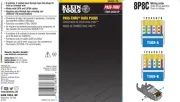
11 Augustus 2025
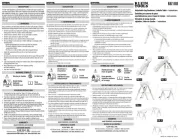
29 Juli 2025
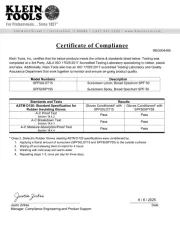
14 Juli 2025
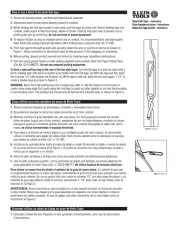
14 Juli 2025
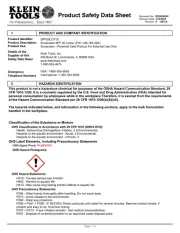
14 Juli 2025
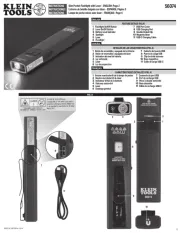
14 Juli 2025
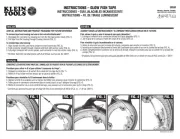
11 Juni 2025
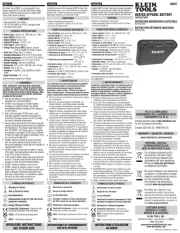
17 Maart 2025
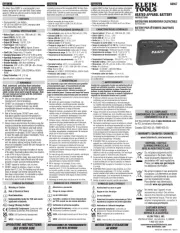
17 Maart 2025
Handleiding Niet gecategoriseerd
- Gem Toys
- Lotus
- Tovsto
- Celestion
- Xmusic
- Oromed
- Accucold
- Fischer Amps
- Dwarf Connection
- Stabo
- Fezz
- LiveU
- Sumiko
- Point Source Audio
- RCA
Nieuwste handleidingen voor Niet gecategoriseerd

13 September 2025

13 September 2025

13 September 2025

13 September 2025

13 September 2025

13 September 2025

13 September 2025

13 September 2025

13 September 2025
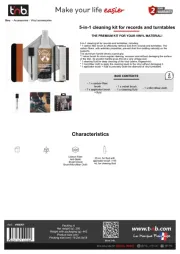
13 September 2025